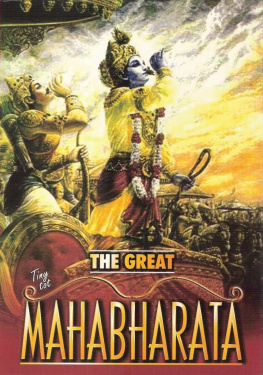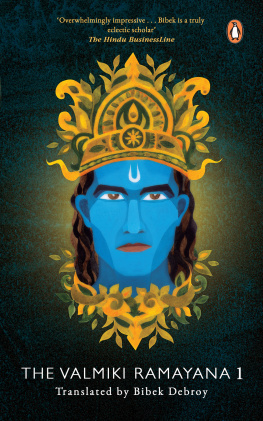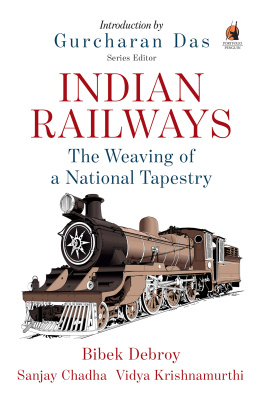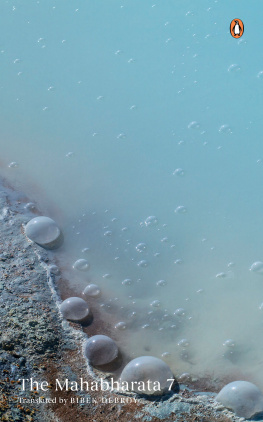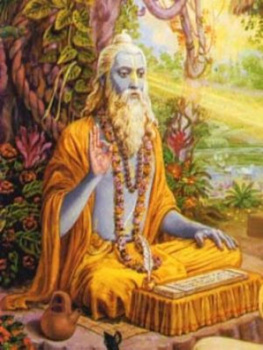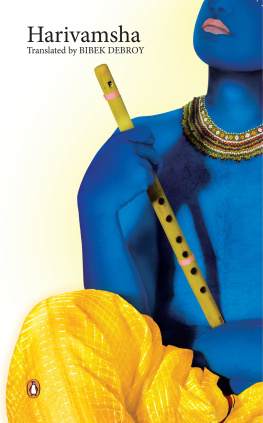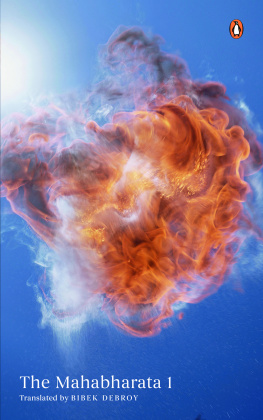Bibek Debroy - Mahabharata Vol-7
Here you can read online Bibek Debroy - Mahabharata Vol-7 full text of the book (entire story) in english for free. Download pdf and epub, get meaning, cover and reviews about this ebook. year: 0, genre: Religion. Description of the work, (preface) as well as reviews are available. Best literature library LitArk.com created for fans of good reading and offers a wide selection of genres:
Romance novel
Science fiction
Adventure
Detective
Science
History
Home and family
Prose
Art
Politics
Computer
Non-fiction
Religion
Business
Children
Humor
Choose a favorite category and find really read worthwhile books. Enjoy immersion in the world of imagination, feel the emotions of the characters or learn something new for yourself, make an fascinating discovery.

- Book:Mahabharata Vol-7
- Author:
- Genre:
- Year:0
- Rating:4 / 5
- Favourites:Add to favourites
- Your mark:
- 80
- 1
- 2
- 3
- 4
- 5
Mahabharata Vol-7: summary, description and annotation
We offer to read an annotation, description, summary or preface (depends on what the author of the book "Mahabharata Vol-7" wrote himself). If you haven't found the necessary information about the book — write in the comments, we will try to find it.
Mahabharata Vol-7 — read online for free the complete book (whole text) full work
Below is the text of the book, divided by pages. System saving the place of the last page read, allows you to conveniently read the book "Mahabharata Vol-7" online for free, without having to search again every time where you left off. Put a bookmark, and you can go to the page where you finished reading at any time.
Font size:
Interval:
Bookmark:


(Sections 73 to 77)


SECTION SEVENTY-THREE
KARNA-VADHA PARVA
After Dronas death, Karna is made the overall commander; Duryodhana asks Shalya to be Karnas charioteer;Bhima kills Duhshasana and drinks his blood; Arjuna kills Karna
SECTION SEVENTY-FOUR
SHALYA-VADHA PARVA
Shalya is appointed the supreme commander of the Kourava army; Yudhishthira kills Shalya and Shalyas younger brother
SECTION SEVENTY-FIVE
HRADA-PRAVESHA PARVA
Bhima kills Duryodhanas remaining brothers; Sahadeva kills Shakuni; Duryodhana enters a lake and hides there
SECTION SEVENTY-SIX
TIRTHA YATRA PARVA
It is discovered that Duryodhana is hiding in Lake Dvaipayana; Bhima and Duryodhana prepare to fight; Balarama returns from his pilgrimage to witness the encounter
SECTION SEVENTY-SEVEN
GADA YUDDHA PARVA
Bhima and Duryodhana fight with clubs, where, Bhima strikes Duryodhana unfairly and brings him down; Krishna goes to Hastinapura and pacifies Dhritarashtra and Gandhari
SECTION SEVENTY-THREE
KARNA-VADHA PARVA
After Dronas death, Karna is made the overall commander; Duryodhana asks Shalya to be Karnas charioteer;Bhima kills Duhshasana and drinks his blood; Arjuna kills Karna
Bibek Debroy is an economist and is Research Professor (Centre of Policy Research) and a columnist with Economic Times. He has worked in universities, research institutes, industry and for the government. He has published books, papers and popular articles in economics. But he has also published in Indology and translated (into English) the Vedas, the Puranas, the Upanishads and the Gita (Penguin India, 2005). His book Sarama and her Children: The Dog in Indian Myth (Penguin India, 2008) splices his interest in Hinduism with his love for dogs. He is currently translating the remaining volumes of the unabridged Mahabharata.
For Suparna
Ardha bhry manuyasya bhry rehatama sakh
Bhry mulam trivargasya bhry mitram mariyata
Mahabharata (1/68/40)
Bharata/Puru lineage





T he Hindu tradition has an amazingly large corpus of religious texts, spanning Vedas, Vedanta (brahmanas, smritis, Puranas, dharmashastras and itihasa. For most of these texts, especially if one excludes classical Sanskrit literature, we dont quite know when they were composed and by whom, not that one is looking for single authors. Some of the minor Puranas (Upa Purana) are of later vintage. For instance, the Bhavishya Purana (which is often listed as a major Purana or Maha Purana) mentions Queen Victoria.
In the listing of the corpus above figures itihasa, translated into English as history. History doesnt entirely capture the nuance of itihasa, which is better translated as this is indeed what happened. Itihasa isnt myth or fiction. It is a chronicle of what happened; it is fact. Or so runs the belief. And itihasa consists of Indias two major epics, the Ramayana and the Mahabharata. The former is believed to have been composed as poetry and the latter as prose. This isnt quite correct. The Ramayana has segments in prose and the Mahabharata has segments in poetry. Itihasa doesnt quite belong to the category of religious texts in a way that the Vedas and Vedanta are religious. However, the dividing line between what is religious and what is not is fuzzy. After all, itihasa is also about attaining the objectives of dharma, and the Mahabharata includes Hinduisms most important spiritual textthe Bhagavad Gita.
The epics are not part of the shruti tradition. That tradition is like revelation, without any composer. The epics are part of the smriti tradition. At the time they were composed, there was no question of texts being written down. They were recited, heard, memorized and passed down through the generations. But the smriti tradition had composers. The Ramayana was composed by Valmiki, regarded as the first poet or kavi. The word kavi has a secondary meaning as poet or rhymer. The primary meaning of kavi is someone who is wise. And in that sense, the composer of the Mahabharata was no less wise. This was Vedavyasa or Vyasadeva. He was so named because he classified (vyasa) the Vedas. Vedavyasa or Vyasadeva isnt a proper name. It is a title. Once in a while, in accordance with the needs of the era, the Vedas need to be classified. Each such person obtains the title and there have been twenty-eight Vyasadevas so far.
At one level, the question about who composed the Mahabharata is pointless. According to popular belief and according to what the Mahabharata itself states, it was composed by Krishna Dvaipayana Vedavyasa (Vyasadeva). But the text was not composed and cast in stone at a single point in time. Multiple authors kept adding layers and embellishing it. Sections just kept getting added and it is no ones suggestion that Krishna Dvaipayana Vedavyasa composed the text of the Mahabharata as it stands today.
Consequently, the Mahabharata is far more unstructured than the Ramayana. The major sections of the Ramayana are known as kandas and one meaning of the word kanda is the stem or trunk of a tree, suggesting solidity. The major sections of the Mahabharata are known as parvas and while one meaning of the word parva is limb or member or joint, in its nuance there is greater fluidity in the word parva than in kanda.
The Vyasadeva we are concerned with had a proper name of Krishna Dvaipayana. He was born on an island (dvipa). That explains the Dvaipayana part of the name. He was dark. That explains the Krishna part of the name. (It wasnt only the incarnation of Vishnu who had the name of Krishna.) Krishna Dvaipayana Vedavyasa was also related to the protagonists of the Mahabharata story. To go back to the origins, the Ramayana is about the solar dynasty, while the Mahabharata is about the lunar dynasty. As is to be expected, the lunar dynasty begins with Soma (the moon) and goes down through Pururava (who married the famous apsara Urvashi), Nahusha and Yayati. Yayati became old, but wasnt ready to give up the pleasures of life. He asked his sons to temporarily loan him their youth. All but one refused. The ones who refused were cursed that they would never be kings, and this includes the Yadavas (descended from Yadu). The one who agreed was Puru and the lunar dynasty continued through him. Purus son Duhshanta was made famous by Kalidasa in the DuhshantaShakuntala story and their son was Bharata, contributing to the name of Bharatavarsha. Bharatas grandson was Kuru. We often tend to think of the Kouravas as the evil protagonists in the Mahabharata story and the Pandavas as the good protagonists. Since Kuru was a common ancestor, the appellation Kourava applies equally to Yudhishthira and his brothers and Duryodhana and his brothers. Kurus grandson was Shantanu. Through Satyavati, Shantanu fathered Chitrangada and Vichitravirya. However, the sage Parashara had already fathered Krishna Dvaipayana through Satyavati. And Shantanu had already fathered Bhishma through Ganga. Dhritarasthra and Pandu were fathered on Vichitraviryas wives by Krishna Dvaipayana.
Font size:
Interval:
Bookmark:
Similar books «Mahabharata Vol-7»
Look at similar books to Mahabharata Vol-7. We have selected literature similar in name and meaning in the hope of providing readers with more options to find new, interesting, not yet read works.
Discussion, reviews of the book Mahabharata Vol-7 and just readers' own opinions. Leave your comments, write what you think about the work, its meaning or the main characters. Specify what exactly you liked and what you didn't like, and why you think so.


